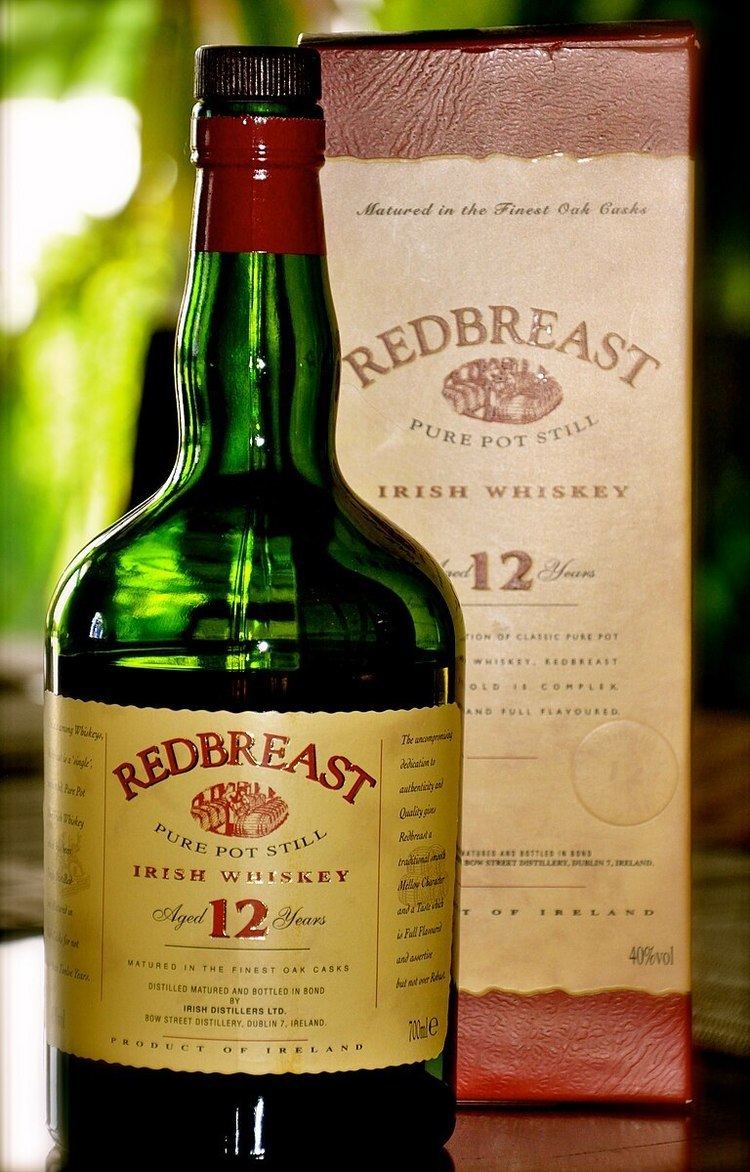Introduced Circa. 1903 | ||
 | ||
Variants 12-year-old, 12-year-old cask strength, 15-year-old, 21-year-old | ||
Redbreast is a brand of single pot still Irish Whiskey produced by Irish Distillers. It was originally produced by Gilbey's, a Dublin spirits merchants using distillate sourced from Jameson's Bow Street Distillery. However, in the 1980s, the brand was purchased by Irish Distillers, the producers of Jameson Irish whiskey. It is the largest selling single pot still Irish whiskey in the world.
Contents
As of 2016, there are five variants are available:
History
W & A Gilbey was founded in London in 1857, and by 1861 had opened a branch on what is now O'Connell Street in Dublin.
At the time, it was customary for distilleries to sell distillate to wine merchants or "bonders", who having amble supply of casks through the importation of fortified wines, would mature the whiskey themselves under bond. By the 1870s, Gilbey's then described as a "wine importer and distiller", had over 300,000 gallons of whiskey from Dublin distilleries in stock under bond, and was selling whiskey to consumers under its own labels. These whiskeys were aged for at least six years in Gilbey's own sherry casks at its bonded warehouses on Dublin's Harcourt Street.
By 1903, a whiskey known as John Jameson & Son’s Castle “JJ Liqueur” Whiskey 12 Years Old was being marketed in a bottle of similar shape and markings to those used for subsequent bottlings of Redbreast. This whiskey was produced using using distillate sourced from the Bow Street Distillery in Dublin, the home of Jameson whiskey. Although this whiskey was likely the forerunner of Redbreast, the first official mention of "Redbreast" only dates from 1912, when Gilbey's referred to the sale of "Redbreast" J.J. Liqueur Whiskey 12 Years Old whiskey. "Redbreast" being a nickname given to one of their whiskeys by Gilbey's then chairman, an avid birdwatcher, in reference to the Robin Redbreast.
In the 1968, Irish Distillers opted to phase out the supply of bonded whiskey to merchants such as Gilbey's. This threatened the future of the whiskey brand, as Irish Distillers controlled all of the whiskey distilleries in operation in Ireland at that point. However, following pleas from Gilbey's, Irish Distillers agreed to continue to supply distillate for the production of Redbreast.
In 1971, Irish Distillers chose to close all of its Dublin distilleries (including Bow Street), and to consolidate production at a the New Midleton Distillery, a purpose-built facility in County Cork. As a result, production of Redbreast whiskey moved from Dublin to Cork.
In 1985, Gilbey's ceased production of Redbreast, and in 1986 entered into an agreement to sell the brand to Irish Distillers.
The brand was subsequently relaunched by Irish Distillers in 1991 after several years of absence from the market. Initially launched as a standalone twelve year old, Redbreast has since been released in 15-year old, 21-year old and other variants.
Bottlings
Initially relaunched in 1991, as a 12 year old, several variants have come to market in recent years, including:
Limited editions, no longer in production, but still available in specialist retailers as of 2016 include:
Accolades
The Redbreast whiskey variations have won several wards in recent years.
Notably, Jim Murray, the whiskey writer and author of the Whisky Bible has rated several variations of Redbreast highly, for instance:
In addition, Redbreast 12-year old and Redbreast Mano a Lámh were both rated a top-ten whiskey buys in John Hansell's Buyer's Guide.
Notability
Redbreast is one of a handful of single pot still whiskeys in existence today, and one of only two to have been produced almost continuously since the early 1900s (the other being Green Spot). Although once the most popular style of whiskey consumed in the world, pot still whiskey fell out of favour in the 20th century, in part due to the rise of cheaper, less intense blended whiskeys. Therefore, as a result of falling demand, most Irish whiskeys were either reformulated as blends or discontinued.
Single pot still whiskeys, which are historically unique to Ireland, are similar to single malts in that they are produced solely from pot still distillate. However, in contrast to malts which only use malted barley in the mash, single pot still whiskeys are produced from a mixed mash which contains both malted and unmalted barley.
